DOI:
10.1039/C5RA18385E
(Paper)
RSC Adv., 2015,
5, 95967-95980
Using maximum entropy approach for prediction of drop size distribution in a pilot plant multi-impeller extraction contactor
Received
8th September 2015
, Accepted 19th October 2015
First published on 19th October 2015
Abstract
In this study, the maximum entropy principle is used to predict the drop size distributions in a multi-impeller column extractor. Three systems, including toluene–water, n-butyl acetate–water and n-butanol–water, were tested in this column. An experimental study of mass transfer conditions was performed in which acetone was transferred between the organic and aqueous phases. The drop size distribution and Sauter mean drop diameter were found to depend largely on the rotor speed and interfacial tension, but were only partially dependent on the phase velocities. Empirical correlations are proposed to describe Lagrange multipliers in the maximum entropy function in terms of the operating variables and physical properties of the systems. In addition, an empirical correlation is proposed for estimation of the Sauter mean drop diameter. Also, the combination of computational fluid dynamics (CFD) and droplet population balance modeling (PBM) has been carried out to predict the drop size distributions. Comparison shows good agreement between the present models and the experimental data. Experimental results show that the maximum entropy function satisfies the droplet size distributions for three systems in a multi-impeller column extractor. The acquired information would be useful in the design of liquid–liquid extraction columns.
1. Introduction
Many industrial processes, such as solvent extraction and emulsification, involve liquid–liquid dispersions in stirred vessels. Knowledge of the evolution of drop size distribution with changes in external mechanical energy input is of major importance in solvent extraction systems. In solvent extraction processes, the interfacial area of the dispersion controls the mass transfer rate and is a major parameter for the design and scaling-up of gravity settlers that provide the ultimate liquid phase separation.1,2
Multi-impeller column extractors have been widely used in chemical processes such as solvent extraction. The unit is neither a compartmental or truly continuously differential device, but has some properties of both. The motion of droplets between compartments in these columns is therefore dependent upon the droplet size, the physical properties of the phases, the phase flow rates and the agitator speed.3,4 The power input to multi-impeller column extractors is thus transferred to the kinetic, surface, potential and heat energy of the droplets. The same mean drop size can be obtained from various drop size distributions which have different interfacial areas. Therefore, the change in mean drop size and drop size distribution with agitation speed is very important in these extractors.5,6 The unified correlations for prediction of the drop size in mechanically agitated columns are shown in Table 1.
Table 1 Unified correlations for prediction of the drop size in mechanically agitated columns
| Equation |
Column |
Reference |
For Reynolds number (Re) ≤ 50![[thin space (1/6-em)]](https://www.rsc.org/images/entities/char_2009.gif) 000 000  (1) (1) |
Rotating disc column |
Kumar and Hartland, 1986 (ref. 39) |
 (2) (2) |
Rotating disc column, asymmetric rotating disc column, Kühni column, Wirtz column, pulsed column, Karr column |
Kumar and Hartland, 1996 (ref. 37) |
 (3) (3) |
Multi-impeller column extractor |
Arnold, et al., 1974 (ref. 40) |
 (4) (4) |
Multi-impeller column extractor |
Tsouris, et al., 1990 (ref. 8) |
 (5) (5) |
Rotating disc column |
Al-Rahawi, 2007 (ref. 41) |
 (6) (6) |
Perforated rotating disc column |
Hemmati, et al., 2015 (ref. 42) |
The effects of agitation speed and mass transfer on the Sauter mean drop diameter in a multi-impeller column extractor were investigated by Komasawa and Ingham, 1978.7 The Sauter mean drop diameter decreases as the rotor speed increases up to a certain agitation level, above which drop breakage and coalescence become equally important and the Sauter mean drop diameter remains unchanged.
Tsouris et al., 1990 (ref. 8) studied experiments in a multi-impeller column extractor and it was observed that drop size distributions were broad in the first stages of the column, becoming narrower with smaller drop sizes along the column.
Several empirical correlations have been proposed to characterize the distribution of droplet sizes in liquid–liquid extraction columns: normal,9,10 log-normal,5,11 Weibull12 and Gamma13 functions.
As an alternative to the empirical approach, analytical approaches to address the problem of modeling droplet size distribution have been developed in the past two decades. There are two different approaches to deal with the hydrodynamics and mass transfer in liquid–liquid extraction columns, i.e. the drop population balance model (DPBM)14–16 and computational fluid dynamics (CFD).17–20
The application of the DPBM implies knowledge of an appropriate model for breakage and coalescence of drops, besides the usual parameters such as holdup, drop diameter and mass transfer coefficients. Later on, a complex mathematical model is applied to solve the equations. The dynamic behavior of particulate processes under the influence of the nonlinear aggregation term, nucleation, growth and breakup was studied using the population balance equation.21 Simulation of extraction of aromatics with the population balance model in a pilot-plant Kühni extractor was investigated by Buchbender and co-workers.22
Computational fluid dynamics has emerged as a potential tool for liquid–liquid extraction studies. It involves the solution of the conservation equations of momentum, mass and volume fractions for different phases at a number of grid points in the column.18 Sufficiently capturing the different aspects of the flows in these columns needs complex hydrodynamics. Therefore, it leads to the requirement of large computational power in terms of capacity and storage.
Other methods for prediction of drop size distribution are the maximum entropy method and probability distribution function. The maximum entropy approach is a method of statistical inference that provides the least biased estimate of a probability distribution, consistent with a set of constraints that express the available information about the relevant phenomena.23,24
There is little literature data on the study of multi-impeller column extractors where the drop size and drop size distribution are investigated experimentally. In addition, a statistical approach has not been attempted to derive the most probable drop size distribution in these columns.
In this article, we investigated measurements of drop size distribution and mean drop diameter across a multi-impeller column extractor and compared these results with predictions obtained using the maximum entropy principle. In the process of making these comparisons, estimates will be made of the constant parameters in the maximum entropy approach as a function of effective variables. In addition, a combination of computational fluid dynamics (CFD) and droplet population balance modeling (PBM) is applied to simulate the drop size distributions. The results from the simulation are compared with the results obtained from the maximum entropy approach.
2. Maximum entropy approach
Maximum entropy is a popular technique that is utilized to construct the probability distribution functions of stochastic fields where limited information is available. There are often limitations on the amount of information available due to the high costs involved in performing a great number of experiments or simulations. The concept of information entropy was developed by Shannon, 1948 (ref. 25) and Jaynes, 1957.26 The principle of this approach in thermodynamics was investigated by Tribus and Princeton.27 They showed that the concepts of heat and temperature in thermodynamics could be defined through the formalism of maximum entropy.
Sobrino et al., 2009 (ref. 28) investigated the maximum entropy approach for the determination of the bubble size distribution in a fluidized bed. The maximum entropy approach has been shown to be a simple procedure that offers many benefits over other procedures applied before for size distribution modeling in fluidized beds.
Droplet size and velocity distributions for spray modeling were reported by Jones and Watkins, 2012.29 The results showed that the maximum entropy function combined with the gamma distribution assure these conditions for the droplet size distributions in spray modeling. The grain size distributions of polycrystalline materials cannot easily be measured experimentally since they vary even at a specific point for different samples of the material. Sankaran and Zabaras, 2007 used the maximum entropy principle to compute probability distribution functions of microstructures based on given information about a microstructural system.30
The idea of the entropy (information uncertainty) of a probability distribution was introduced by Shannon, 1948 (ref. 25), who showed that for the different states of a material, each of them having the probability (Pi), the uncertainty of the probability distribution is given by
| |
 | (7) |
where
k is a constant parameter and
n is the number of states of the material. Because of its similarity to thermodynamic entropy,
S is named Shannon’s entropy. The limitations mathematically express the mean values of information accessible. If
fk(
D) is a function describing a droplet property, such as mass or momentum, and its known mean value over all droplets is
Fk, the corresponding constraint written for all the size classes is:
| |
 | (8) |
In the case of mass conservation (fk(Di) = mi), the mass m before droplet breakage in the column must be equal to the sum of all droplet masses after droplet breakage:
| |
 | (9) |
In eqn (9), n is the number of drop size classes, Di is the arithmetic mean diameter of the drops in size class i, N is the total number of drops within the control volume and Pi is the probability parameter that a droplet is in size class i. The definition of the relevant parameters is shown in Fig. 1. The inclusion of the mean drop diameter d30 via the relation  finally results in the mass conservation constraint for the maximum entropy function:
finally results in the mass conservation constraint for the maximum entropy function:
| |
 | (10) |
 |
| | Fig. 1 Definition of relevant parameters in droplet size distribution. | |
Another constraint arises from the normalization of the set of probabilities:
| |
 | (11) |
By using Lagrange multipliers (λ), the probability distribution function is defined as:
| |
 | (12) |
where
r is a counter,
m is the number of constrains and
fr(
di) is average value.
By using the constraints in eqn (10) and (11), the relationship between Lagrange multipliers is obtained as follows:
| |
 | (13) |
| |
 | (14) |
The above equations in continuous space for drop size distribution are rewritten as follows:
| |
 | (15) |
| |
 | (16) |
| |
 | (17) |
| |
 | (18) |
| |
 | (19) |
The problem of finding the most likely size distribution is expressed mathematically by a maximization problem. The maximum of the function defined in eqn (15) has to be calculated subject to the constraints. The general result of the application of the above equations to a particular problem is:
| | |
Pi = exp(−λ0 − λ1f12(di) − λ2f23(di))
| (20) |
where the set of
λ is a collection of Lagrange multipliers which must be evaluated for each particular solution. The constraints (
eqn (16)–(19)) are used to evaluate the Lagrange multipliers, which results in a system of non-linear equations that have to be solved.
3. Numerical approach
A combination of computational fluid dynamics (CFD) and droplet population balance modeling (PBM) is applied to simulate the drop size distributions. The CFD equation can predict the energy dissipation, volume fraction and velocity, while PBM can account for the droplet coalescence and breakup and predict the size distribution of the dispersed phase. The finite-difference numerical method was used for solving the combination of CFD and PBM equations with Matlab software; the schematic of this procedure is shown in Fig. 2.
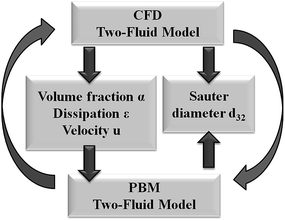 |
| | Fig. 2 Two fluid CFD and PBM model. | |
3.1. Eulerian–Eulerian model
An Euler–Euler model, where both phases are treated mathematically as interpenetrating continua, was applied for the two-phase simulations of the extraction column. The continuity and conservation of momentum equations for the continuous phase are:| |
 | (21) |
| |
 | (22) |
where α, ρ, u, τ, p, g and Fin represent the volume fraction, phase density, phase velocity, stress–strain tensor, pressure, gravitational acceleration and interfacial force, respectively. In addition to eqn (21) and (22), the constraint for the volume fraction must be satisfied:
The interphase interaction term Fin consists of different momentum exchange mechanisms. The drag force is calculated as follows:
| |
 | (24) |
where the drag coefficient
Cd was described by the model of Schiller–Naumann in simulation.
31
3.2. Turbulence k–ε model
A standard k–ε model is used to capture the effect of the turbulence of the continuous phase. The kinetic energy (k) and energy dissipation (ε) are described for the continuous phase by the following equations:| |
 | (25) |
| |
 | (26) |
where, Gk,c represents the generation of turbulence kinetic energy because of mean velocity gradients, Πk,c and Πε,c represent the influence of the dispersed phase on the continuous phase and the values for C1, C2, Cμ, σk and σε were reported by Kerdouss and co-workers.32
3.3. Population balance model
The drop population balance model is based on the definition of a number density function n(x, V, t) representative of the volume distribution of drop sizes at a level x in the column.
The unsteady state drop population balance is given by the following equation:
| |
 | (27) |
where
P(
V,
t) explicitly takes into account the influence of breakage and coalescence processes. For each former mechanism, one can define, respectively, two functions, PB(
V,
t) and PC(
V,
t), that can be divided into generation and sink terms for a drop class
d, so that:
| | |
P(V, t) = PB+(V, t) − PB−(V, t) + PC+(V, t) − PC−(V, t)
| (28) |
In the latter expression, PB+(V, t) indicates droplets which are larger than d, and PB−(V, t) indicates the output term due to breakage of drops of class d. PC+(V, t) represents the input term due to coalescence of drops, the diameters of which are smaller than d, and PC−(V, t) represents the output term due to the coalescence of drops of class d with any other drop. The graphical representation of PB(V, t) and PC(V, t) in the population balance equation is shown in Fig. 3 and the birth and death rates are given by
| |
 | (29) |
| | |
PB−(V, t) = gb(V)n(V, t)
| (30) |
| |
 | (31) |
| |
 | (32) |
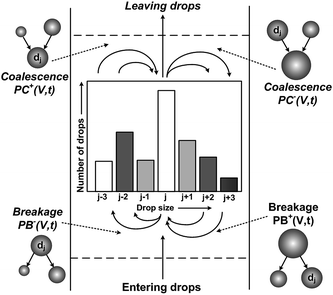 |
| | Fig. 3 Graphical representation of the different expressions in the drop population-balance equation. | |
The breakage rate expression in eqn (29) includes the probability density function β, which describes the distribution of the daughter droplets from the splitting mother particle V′ and the breakage frequency gb.
The aggregation kernel a in eqn. (31) and (32) accounts for the probability of successful collisions between pairs of droplets. It is defined as the product of the collision frequency h and the coalescence efficiency δ:
| | |
a(V, V′) = h(V, V′)·δ(V, V′)
| (33) |
The breakage and coalescence in the dispersed phase was described by the hydrodynamic model of Coulaloglou and Tavlarides.33 The coalescence term uses the frequently applied structure of the product of drop–drop collision frequency and coalescence efficiency. This model is given by the following set of equations:
| |
 | (34) |
| |
 | (35) |
| |
 | (36) |
where
C1,
C2,
C3 and
C4 are adjustable parameters in the above equations. The originally used normal density function for the daughter droplet distribution of Valentas and co-workers,
34 which assumes binary breakage, is also adopted here:
| |
 | (37) |
4. Experimental
4.1. Chemical systems
Three systems with different interfacial tensions, consisting of toluene–water (high interfacial tension), n-butyl acetate–water (medium interfacial tension) and n-butanol–water (low interfacial tension), were used for experiments without mass transfer. Two systems involving toluene–acetone–water and n-butyl acetate–acetone–water were used for experiments with two directions of mass transfer. The European Federation of Chemical Engineering (E.F.C.E) has adopted these systems as official test systems for investigation of extraction.35 The physical properties for the three systems are shown in Table 2. The purities of the organic phase solvents are more than 99.5% and all solvents are used without purification. In experiments with mass transfer, dilute solutions were investigated with approximately 3.5 wt% acetone as transferred solute in the organic or aqueous phase.
Table 2 Physical properties of systems studied at 20 °C.35
| Physical property |
Toluene–water |
n-Butyl acetate–water |
n-Butanol–water |
| ρc [kg m−3] |
998.2 |
997.6 |
985.6 |
| ρd [kg m−3] |
865.2 |
880.9 |
846.0 |
| μc [mPa s] |
0.963 |
1.027 |
1.426 |
| μd [mPa s] |
0.854 |
0.734 |
3.364 |
| σ [mN m−1] |
36 |
14.1 |
1.75 |
4.2. Multi-impeller column extractor experiments
The schematic flow diagram of the multi-impeller column extractor is shown in Fig. 4. The column was made of a cylindrical glass section and was equipped with impellers with accurate speed control, whereas the internal parts were constructed of stainless steel. The main section was made of Pyrex glass, 113 mm I.D, and the height of the column with nine stages was 700 mm. The nine stages were formed by rings of 25% free area as compared with the column cross-sectional area. Mixing was done by nine 6-blade impellers of 50 mm diameter located at the center of each stage and these impellers were driven by an electric motor via a variable gearbox.
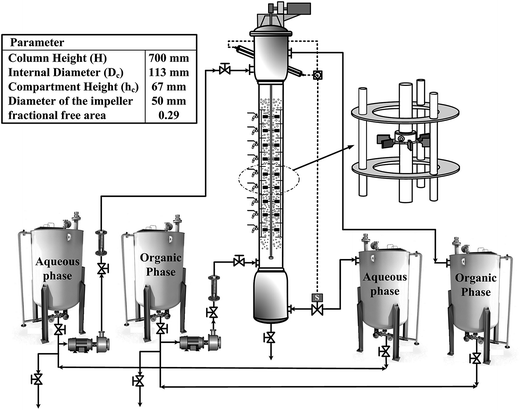 |
| | Fig. 4 Schematic flow diagram of multi-impeller column extractor. | |
The organic phase (dispersed phase) and water (continuous phase) were fed into the extraction column at the bottom and on the top, respectively, in the counter-current mode. Two flow meters were employed to supply and monitor the fixed flow rates of the continuous and dispersed phases. The inlet and outlet of the column were connected to four tanks, each with 85 L capacity. The interface was maintained at the required level by means of an optical sensor as previously described.36
When the operation reached a steady state condition, the inlet and outlet valves were quickly closed. The dispersed phase was allowed to settle and the difference in the interface level location was used to measure the total holdup. The acetone concentrations of the input and output streams of the column for continuous and dispersed phases were analyzed by UV-visible spectroscopy.
4.3. Drop size measurement
The drop size was measured by means of a very high-resolution Nikon D5000 digital camera used to take a digital photo of the extractor contents. Next, droplet dimensions were compared with the thickness of the stators as a reference size in these pictures. The four different heights of the active column were selected to determine the size of droplets.
The curved surface of the glass extraction column and the significant differences between the air and glass refractive indices were found to lead to a parallax deformation of the objects photographed in the column extractor. In order to exclude this phenomenon, a container filled with water was attached to the extraction contactor and the photographic approach was adopted to calculate the size of the stator thickness serving as the reference for measurements of drop size. Consequently, digital image analysis software was applied in order to investigate the taken high quality photograph. Finally, a minimum of 1000 drops were analyzed for each experimental picture in order to guarantee the statistical significance of the determined size distributions. The Sauter mean diameter was calculated from the following equation:
| |
 | (38) |
where
ni denotes the number of drops of diameter
di.
5. Results and discussion
5.1. Mean drop size
The experimental results for Sauter mean drop size with agitation speed are shown in Fig. 5. The significant result to observe is that the Sauter mean drop diameters decrease with an increase in agitation speed. The explanation for this effect is related to the increment in the frequency of drop collisions against the internal parts of the column extractor in more turbulent fluid flow in their ascending path inside the equipment.
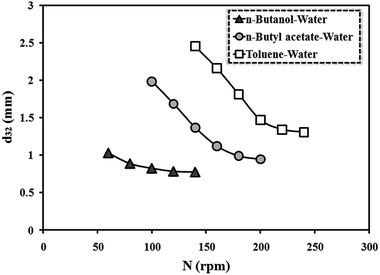 |
| | Fig. 5 The variation of the Sauter mean drop diameter with rotor speed (Vc = Vd = 0.66 mm s−1). | |
The effects of the dispersed and continuous phase velocities on the mean drop diameter were tested, which are illustrated in Fig. 6 and 7. The mean drop diameter increased with an increase in dispersed phase velocity, while a slight increase occurred at low interfacial tension. This observation relates to the increasing drop collisions with the acceleration of the dispersed phase velocity and consequently the increasing coalescence frequency among the drops. According to Fig. 7, the variations in the mean drop diameter with increasing continuous phase velocity are insignificant.
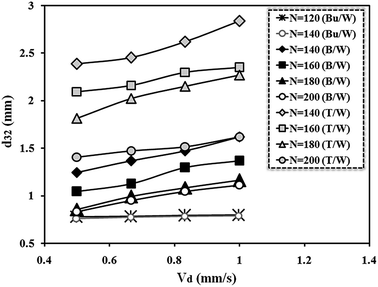 |
| | Fig. 6 The variation of the Sauter mean drop diameter with the dispersed phase velocity for the binary systems of toluene–water (T/W), n-butyl acetate–water (B/W) and n-butanol–water (Bu/W) (Vc = 0.66 mm s−1). | |
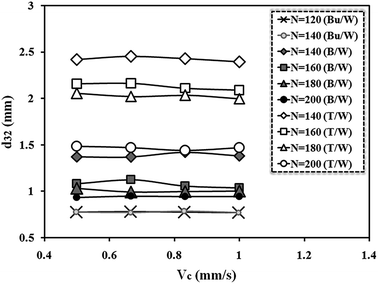 |
| | Fig. 7 The variation of the Sauter mean drop diameter with the continuous phase flow rate for the binary systems of toluene–water (T/W), n-butyl acetate–water (B/W) and n-butanol–water (Bu/W) (Vd = 0.66 mm s−1). | |
To supplement the investigation into the effect of the operating parameters used in this study, three systems were adopted to check the effect of the system properties (interfacial tension) on the mean drop diameters. The pictures of drop sizes for the three systems are shown in Fig. 8.
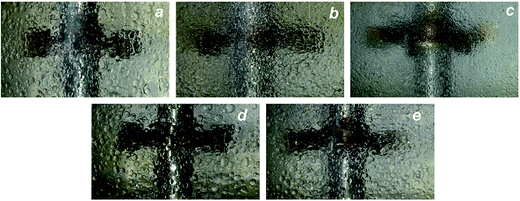 |
| | Fig. 8 The photos of drops for three systems without mass transfer conditions, (a) toluene–water, (b) n-butyl acetate–water and (c) n-butanol–water, and for toluene–acetone–water with mass transfer, (d) d to c transfer and (e) c to d transfer (Vc = Vd = 0.66 mm s−1, N = 140 rpm). | |
From the results presented in Fig. 5–8, it was observed that smaller drops were generated from the low interfacial tension system (n-butanol–water) rather than from the medium or higher interfacial tension system (n-butyl acetate–water or toluene–water).
When there is no agitation, the ratio of buoyancy to interfacial tension forces is responsible for the breakup of the drops and formation of smaller drops. Thus, the drop size can be predicted by the following equation:
| |
 | (39) |
where the constant,
C, is a function of the column geometry and mass transfer, and may also depend upon the liquid–liquid system employed.
37 According to
eqn (39), a decrease in droplet size is expected with a decrease in the interfacial tension of the system.
The effect of mass transfer direction on mean drop sizes is shown in Fig. 8–10. The presence of a solute tends to lower the interfacial tension between the two immiscible liquids.
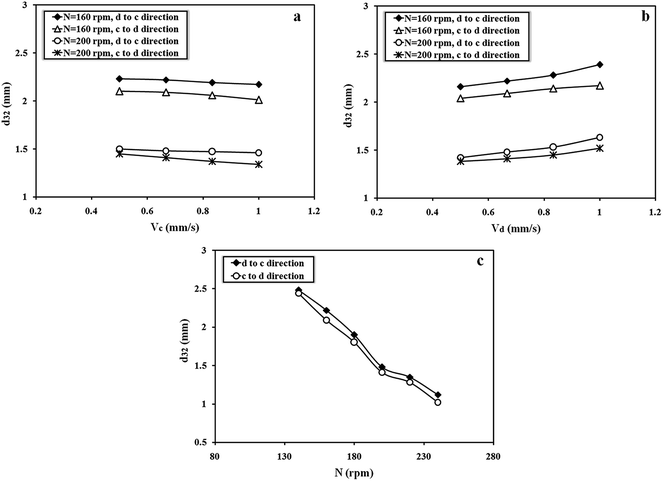 |
| | Fig. 9 Effect of mass transfer direction on the Sauter mean drop diameter for toluene–acetone–water: (a) variation with Vc (Vd = 0.66 mm s−1), (b) variation with Vd (Vc = 0.66 mm s−1), (c) variation with rotor speed (Vd = Vc = 0.66 mm s−1). | |
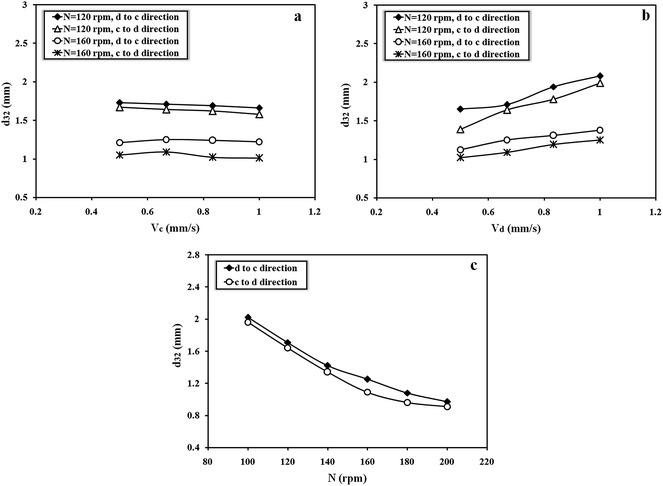 |
| | Fig. 10 Effect of mass transfer direction on the Sauter mean drop diameter for n-butyl acetate–acetone–water: (a) variation with Vc (Vd = 0.66 mm s−1), (b) variation with Vd (Vc = 0.66 mm s−1), (c) variation with rotor speed (Vd = Vc = 0.66 mm s−1). | |
The drop behavior could be due to Marangoni thin film phenomena. When the mass transfer direction occurs from the dispersed to the continuous phase (d to c), the solute concentration in the draining film between the two adjacent drops will be higher than in the surrounding continuous liquid. As for mass transfer in the opposite direction (c to d), the concentration will be correspondingly lower. The gradients of interfacial tension will accelerate drainage and coalescence in the former case and retard drainage and inhibit coalescence in the latter case. Therefore, d to c transfer tends to produce larger drops and c to d transfer is apt to produce smaller drops.
5.1.1. Comparison of the experimental results with previous correlation and prediction of new correlation. The previous correlations in Table 1 were selected for comparison with the experimental data. The results of the comparison are presented in Fig. 11 and Table 3. It is obvious from the results that the previous correlations could not accurately predict and fit the measured data. They particularly failed to represent the effects of the mass transfer direction on the Sauter mean drop diameter; they were proposed for only the toluene–water system.
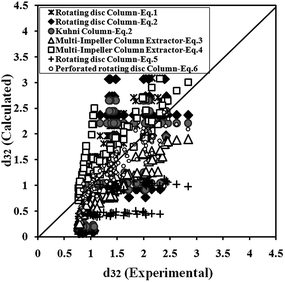 |
| | Fig. 11 Comparison of the values calculated from previous correlation in Table 1 with experimental results. | |
Table 3 The values of AARE in the predicted values of Sauter mean drop diameter obtained from previous correlations
| Equation |
Averaged absolute values of the relative error (AARE) |
| Rotating disc column, eqn 1 |
38.42% |
| Rotating disc column, eqn 2 |
51.29% |
| Kühni column, eqn 2 |
43.90% |
| Multi-impeller column extractor, eqn 3 |
36.57% |
| Multi-impeller column extractor, eqn 4 |
37.94% |
| Rotating disc column, eqn 5 |
69.99% |
| Perforated rotating disc column, eqn 6 |
26.35% |
The following correlation is derived for the mean drop size in the multi-impeller column extractor based on the operating parameters, physical properties and column geometry. This correlation is derived based on the experimental results of the present work and the data taken from other researchers in Table 1.
| |
 | (40) |
The effect of mass transfer and column geometry on the Sauter mean drop diameter is shown by the constant parameters, C1, C2 and C3 in the above equation, respectively. The values of these parameters are presented in Table 4.
Table 4 The constants and AARE values of eqn (40)
| Mass transfer condition |
C1 |
C2 |
C3 |
AARE% |
| No. mass transfer |
3.36 × 10−4 |
−0.434 |
−0.711 |
7.48 |
| Continuous to dispersed transfer (c → d) |
1.96 × 10−4 |
−0.806 |
−0.820 |
7.26 |
| Dispersed to continuous transfer (d → c) |
2.78 × 10−4 |
−0.548 |
−0.689 |
10.71 |
A comparison of the prediction of the proposed correlation was carried out, as shown in Fig. 12. Also, a comparison of the experimental data of Al-Aswad et al., 1985 (ref. 38) for an RDC column and of other researchers mentioned in Table 1 with that predicted by the new correlation is illustrated in this figure. The figures shown correlate the predicted values with the experimentally measured ones under different operating conditions and the results with other researchers.
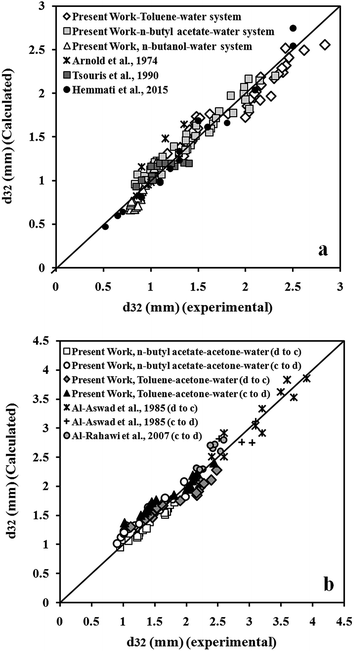 |
| | Fig. 12 Comparison between experimental data and the evaluated values using eqn (40) for (a) no mass transfer condition and (b) two directions of mass transfer conditions. | |
5.2. Drop size distribution
The drop size distributions have a particular form (narrow, wide, few large drops, few small drops) for different extraction columns. Knowledge of the effect of variation in fluid physical properties, column geometry and operating parameters on drop size distribution is crucial if control of the resulting distribution is to be realized.
5.2.1. Effect of operating parameters on drop size distribution. The variation in amount of drop size distribution for three different systems with rotor speed is shown in Fig. 13. The drop size distributions shifted to the left with an increase in agitation, thus evidencing that smaller droplets and more uniform distributions are obtained in more turbulent conditions. This is expected since increasing the agitation speed results in greater average and maximum turbulent energy dissipation per unit mass. This greater turbulence energy results in greater drop breakage rates and/or smaller coalescence rates. The latter is due to the hindering of the coalescence of colliding drops by the increased turbulent energy dissipation. In addition, the collision between the organic liquid drops and the internal wall in more turbulent environments leads to the decrease in drop diameter.
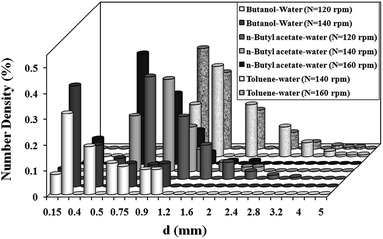 |
| | Fig. 13 Effect of rotor speed on the drop size distribution (m°c = 0.665 kg (m2 s)−1, m°d = 0.577 kg (m2 s)−1). | |
The effect of interfacial tension on drop size distributions is shown in Fig. 13. The drops produced by n-butanol–water (lower interfacial tension) are smaller and more uniform in size than the ones produced by the other systems.
Fig. 14 and 15 show the drop size distribution for different dispersed and continuous phase velocities. A quasi Gaussian distribution is obtained over the whole range of velocities studied. No significant effect was observed in the drop size distribution with variation in the flow rate of the dispersed or continuous phase. Thus, the drop size distribution is independent of both phase flow rates.
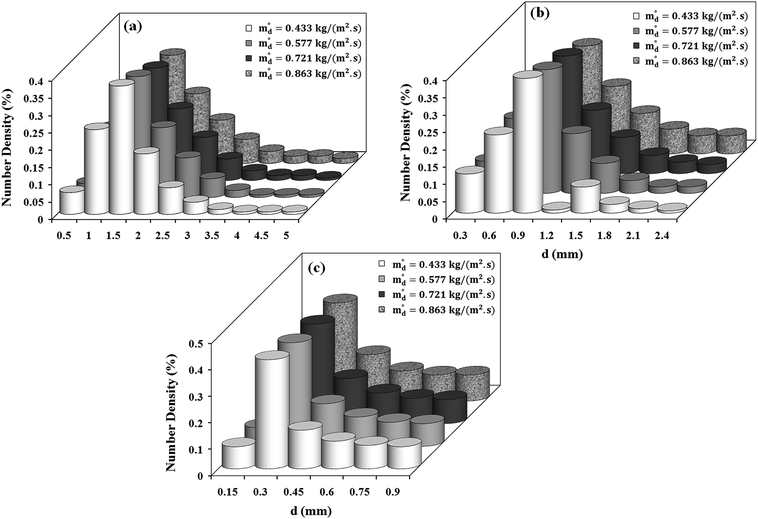 |
| | Fig. 14 Effect of dispersed phase flow rate on the drop size distribution at the same rotor speed for the binary systems of (a) toluene–water (T/W), (b) n-butyl acetate–water (B/W) and (c) n-butanol–water (Bu/W) (N = 140 rpm, m°c = 0.665 kg (m2 s)−1). | |
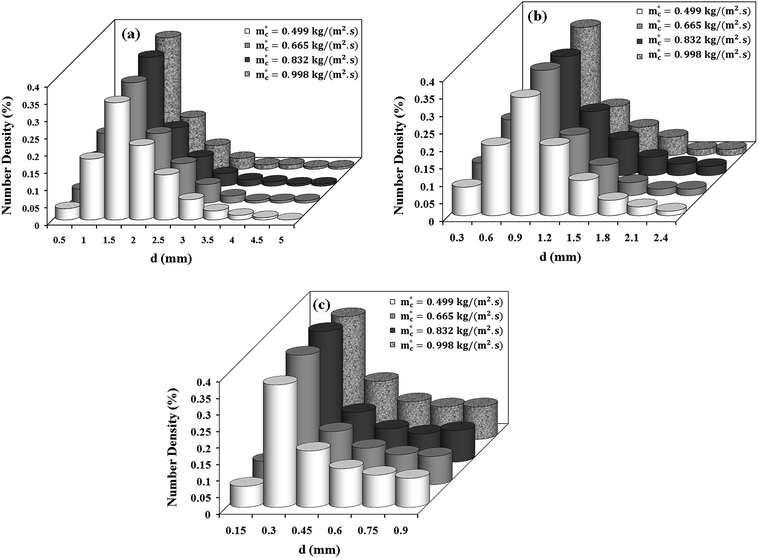 |
| | Fig. 15 Effect of continuous phase flow rate on the drop size distribution at the same rotor speed for the binary systems of (a) toluene–water (T/W), (b) n-butyl acetate–water (B/W) and (c) n-butanol–water (Bu/W) (N = 140 rpm, m°c = 0.577 kg (m2 s)−1). | |
5.2.2. Maximum entropy approach for drop size distribution. The maximum entropy principles were applied to obtain the probability density distributions for drops in the multi-impeller column contactor. The probability density is the ratio of the number of drops with a certain diameter to the total number of drops. In order to compare the experimental drop size distributions with the distribution function expressed by maximum entropy in eqn (20), it is necessary to determine the Lagrange multipliers (λ). The evaluated parameters for λ0, λ1 and λ2 were correlated as a function of the operating variables and physical properties of the systems. The derived correlations are given below:| |
 | (41) |
| |
 | (42) |
| |
 | (43) |
In the latter equations, N, dR, ρc, μc, μd, σ, Δρ, Vc, Vd and g denote the agitation speed, rotor diameter, density of the continuous phase, viscosity of the continuous phase, viscosity of the dispersed phase, interfacial tension, density difference between continuous and dispersed phases, continuous velocity, dispersed velocity and gravity acceleration, respectively. It is observed from the above equations that the drop size distribution profiles are significantly affected by rotational speed and surface tension.
Each experimental drop size histogram was compared with the probability density function from the maximum entropy approach and the average absolute relative errors (AAREs) were calculated using the following equation:
| |
 | (44) |
where
n denotes the number of data points, and
Pi(
d)(exp) and
Pi(
d)(theo) denote the experimental and maximum entropy estimation number densities of the drops, respectively.
The values of AARE are shown in Table 5. It is observed that the use of maximum entropy principles was found to result in good agreement with the experimental data.
Table 5 The obtained average absolute relative errors for estimation of Lagrange multipliers in the maximum entropy function
| Parameter of the distribution |
AARE (%) |
| λ0 |
8.86 |
| λ1 |
9.27 |
| λ2 |
10.67 |
5.2.3. Comparison of maximum entropy approach with PBM and CFD simulation. In order to test the validity of the maximum entropy method, the results from this method are compared with the experimental data and the results from PBM and CFD simulation. The comparison of the results is shown in Fig. 16. It is observed that the experimental data are close to the predicted results from the two methods. It is found that the results are predicted with 10.5% and 6.5% relative error with the maximum entropy method and PBM and CFD simulation, respectively. The differences between the experimental data and the simulated results with PBM and CFD increase as the level of agitation increases. The differences are attributed to inadequacies of the breakage and exit frequencies, and reflect the lack of experimental information on the continuous phase hydrodynamics and the velocity of drops in the multi-impeller column. The results obtained with the maximum entropy method are independent from the information for breakage and coalescence processes. In addition, the solution program time for prediction with this method is very low in comparison with PBM and CFD simulation. Therefore, the maximum entropy method will be useful for prediction of the drop size distribution in liquid–liquid extraction columns without the requirement for the solutions of population balance equations.
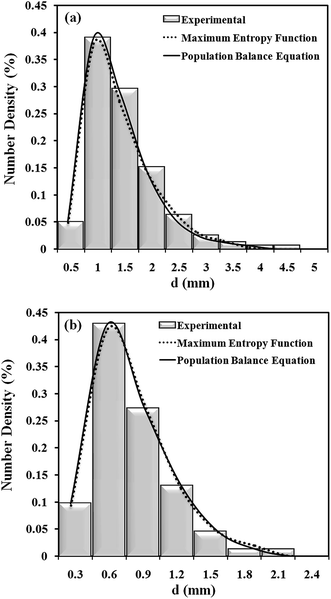 |
| | Fig. 16 Comparison of maximum entropy distribution functions with a broad drop size distribution for (a) toluene–water and (b) n-butyl acetate–water (N = 140 rpm, m°c = 0.665 kg (m2 s)−1, m°d = 0.577 kg (m2 s)−1). | |
6. Conclusion
The drop size distribution and Sauter mean drop size in a multi-impeller column extractor were investigated in this research work. The drop size could be decreased with increasing agitation speed and decreasing dispersed phase flow rate, but the continuous phase flow rate does not have a significant effect. Also, it is observed that the direction of mass transfer influenced the Sauter mean drop diameter. The maximum entropy method has been used to derive the most probable drop size distribution in this column. The drop size distribution predicted from the statistical approach is compared with experimental data and the computational fluid dynamics and droplet population balance modeling to evaluate the maximum entropy approach developed in this study. The drop size distribution has been correlated to the operating parameters and physical properties for the three systems in the frame of the maximum entropy method. It is observed that the maximum entropy method reliably estimates the probability drop size distribution in a multi-impeller column extractor and would be useful for liquid–liquid extraction processes where the drop breakup is stochastic in nature.
Abbreviations
| a | Coalescence rate (s−1) |
| AARE | Average absolute relative error (-) |
| Cd | Drag coefficient (-) |
| CII | Constant parameter in eqn (2) (-) |
| Cψ | Constant parameter in eqn (2) (-) |
| CΩ | Constant parameter in eqn (2) (-) |
| d30 | Volume drop diameter (m3) |
| d32 | Sauter mean drop diameter (m) |
| Dc | Column diameter (m) |
| Di | Droplet diameter (m) |
| dR | Rotor diameter (m) |
| e | Power dissipated per unit mass (m2 s3) |
| Fin | Force interaction (N) |
| Fc,d | Drag force (N) |
| g | Acceleration due to gravity (m s−2) |
| gb | Breakage frequency (s−1) |
| H | Effective height of the column (m) |
| hc | Compartment height (m) |
| h | Collision frequency (s−1) |
| k | Kinetic energy (m2 s−2) |
| m | Mass (kg) |
| m° | Mass flow rate per surface area (kg (m2 s)−1) |
| N | Rotor speed (s−1) |
| ni | Number of droplets of mean diameter di (-) |
| P | Probability of number density (-) |
| Q | Flow rate of the continuous or dispersed phase (m3 s−1) |
| S | Shannon entropy (-) |
| u | Phase velocity (m s−1) |
| V | Superficial velocity (m s−1) |
| Vi | Impeller tip velocity (m s−1) |
| Vk | Characteristic velocity (m s−1) |
Greek letters
| σ | Interfacial tension (N m−1) |
| α | Volume fraction (-) |
| β | Probability density function (-) |
| δ | Coalescence efficiency (s−1) |
| Δρ | Density difference between phases (kg m−3) |
| ε | Energy dissipation (m2 s−3) |
| η | Cross sectional area (-) |
| λ | Lagrange multipliers of probability maximum entropy function |
| μ | Viscosity (Pa s) |
| ρ | Density (kg m−3) |
| ρm | Density of dispersion (kg m−3) |
| τ | Stress–strain tensor (N m−1) |
| φ | Dispersed phase holdup (-) |
Subscripts
| c | Continuous phase |
| d | Dispersed phase |
References
- V. S. Kislik, Solvent Extraction: Classical and Novel Approaches, Elsevier, New York, 2012 Search PubMed.
- J. C. Godfrey and M. J. Slater, Liquid–Liquid Extraction Equipment, Wiley, New York, 1994 Search PubMed.
- J. H. Rushton, S. Nagata and T. B. Rooney, AIChE J., 1964, 10, 298–302 CrossRef.
- L. Steiner, E. V. Fisher and S. Hartland, AIChE Symp. Ser., 1984, 80, 130–138 CAS.
- N. S. Oliveira, D. M. Silva, M. P. C. Gondim and M. B. Mansur, Braz. J. Chem. Eng., 2008, 25, 729–740 CrossRef CAS.
- J. Rydberg, C. Musikas and G. R. Choppin, Solvent Extraction Principles and Practice, CRC Press, New York, 2004 Search PubMed.
- I. Komasawa and J. Ingham, Chem. Eng. Sci., 1978, 33, 479–485 CrossRef CAS.
- C. Tsouris, R. Ferreira and L. L. Tavlarides, Can. J. Chem. Eng., 1990, 68, 913–923 CrossRef CAS.
- S. H. Zhang, S. C. Yu, Y. C. Zhou and Y. F. Su, Can. J. Chem. Eng., 2009, 63, 212–226 CrossRef.
- W. L. Chen, L. M. Zhong, L. Chen and W. Weiyang, Chem. Eng. Sci., 2013, 102, 622–631 CrossRef.
- E. Moreira, L. M. Pimenta, L. L. Carneiro, R. C. L. Faria, M. B. Mansur and J. P. Ribiero, Chem. Eng. Commun., 2007, 192, 1017–1035 CrossRef.
- L. S. Tung and R. H. Luecke, Ind. Eng. Chem. Process Des. Dev., 1986, 25, 664–673 CAS.
- L. M. Rincon-Rubio, A. Kumar and S. Hartland, Chem. Eng. Res. Des., 1994, 72, 493–502 CAS.
- A. S. Ismail, Can. J. Chem. Eng., 2002, 82, 1037–1043 CrossRef.
- T. Steinmetz and H. J. Bart, Chem. Eng. Technol., 2009, 32, 693–709 CrossRef CAS.
- M. Attarakih, M. Abu-Khader and H. J. Bart, Chem. Eng. Sci., 2013, 91, 180–196 CrossRef CAS.
- J. M. Bujalski, W. Yang, J. Nikolov, C. B. Solnordal and M. P. Schwarz, Chem. Eng. Sci., 2006, 61, 2930–2938 CrossRef CAS.
- R. L. Yadav and A. W. Patwardhan, Chem. Eng. Res. Des., 2009, 87, 25–35 CrossRef CAS.
- G. U. Din, I. R. Chughtai, M. H. Inayat, I. H. Khan and N. K. Qazi, Sep. Purif. Technol., 2010, 73, 302–309 CrossRef CAS.
- F. Onink, C. Drumm, G. W. Meindersma, H. J. Bart and A. B. d. Haan, Chem. Eng. J., 2010, 160, 511–521 CrossRef CAS.
- A. Hasseinea and H. J. Bart, Appl. Math. Model., 2015, 39, 1975–1984 CrossRef.
- F. Buchbender, F. Onink, W. Meindersma, A. d. Haan and A. Pfenning, Chem. Eng. Sci., 2012, 82, 167–176 CrossRef CAS.
- E. Babinsky and P. E. Sojka, Prog. Energy Combust. Sci., 2002, 28, 303–329 CrossRef CAS.
- M. Tembely, C. Lecot and A. Soucemarianadin, Appl. Therm. Eng., 2011, 31, 656–667 CrossRef.
- A. Shannon, Bell Syst. Tech. J., 1948, 27, 379–423 CrossRef.
- E. T. Jaynes, Phys. Rev., 1957, 106, 620–630 CrossRef.
- M. Tribus and N. Princeton, Thermostatics and Thermodynamics, Van Nostrand, New York, 1961 Search PubMed.
- C. Sobrino, J. A. Almendros-Ibáñez, D. Santana, C. Vázquez and M. de Veg, Chem. Eng. Sci., 2009, 64, 2307–2319 CrossRef CAS.
- D. P. Jones and A. P. Watkins, J. Comput. Phys., 2012, 231, 676–692 CrossRef.
- S. Sankaran and N. Zabaras, Acta Mater., 2007, 55, 2279–2290 CrossRef CAS.
- L. Schiller and Z. Naumann, Z. Ver. Deutsch. Ing., 1935, 77–318 Search PubMed.
- F. Kerdouss, A. Bannari and P. Proulx, Chem. Eng. Sci., 2006, 61, 3313–3322 CrossRef CAS.
- C. A. Coulaloglou and L. L. Tavlarides, Chem. Eng. Sci., 1977, 32, 1289–1297 CrossRef CAS.
- K. J. Valentas, O. Bilous and N. R. Amundson, Ind. Eng. Chem. Fundam., 1966, 5, 271–279 CAS.
- T. Míšek, R. Berger and J. Schroter, Standard test systems for liquid extraction studies, EFCE Publ. Ser., 1985 Search PubMed.
- M. Torab-Mostaedi, A. Ghaemi and M. Asadollahzadeh, Can. J. Chem. Eng., 2012, 90, 1569–1577 CrossRef CAS.
- A. Kumar and S. Hartland, Ind. Eng. Chem. Res., 1996, 35, 2682–2695 CrossRef CAS.
- K. K. AL-Aswad, C. J. Mumford and G. V. Jeffreys, AIChE J., 1985, 31, 1488–1497 CrossRef CAS.
- A. Kumar and S. Hartland, Can. J. Chem. Eng., 1986, 64, 915–924 CrossRef CAS.
- D. R. Arnold, C. J. Mumford and G. V. Jeffreys, in International Solvent Extraction Conference ISEC’74, Lyon, September, 1974 Search PubMed.
- A. M. I. Al-Rahawi, Chem. Eng. Technol., 2007, 30, 184–192 CrossRef CAS.
- A. Hemmati, M. Torab-Mostaedi, M. Shirvani and A. Ghaemi, Chem. Eng. Res. Des., 2015, 96, 54–62 CrossRef CAS.
|
| This journal is © The Royal Society of Chemistry 2015 |
Click here to see how this site uses Cookies. View our privacy policy here. ![[thin space (1/6-em)]](https://www.rsc.org/images/entities/char_2009.gif) 000
000  (1)
(1) (2)
(2) (3)
(3) (4)
(4) (5)
(5) (6)
(6)


 finally results in the mass conservation constraint for the maximum entropy function:
finally results in the mass conservation constraint for the maximum entropy function:













































